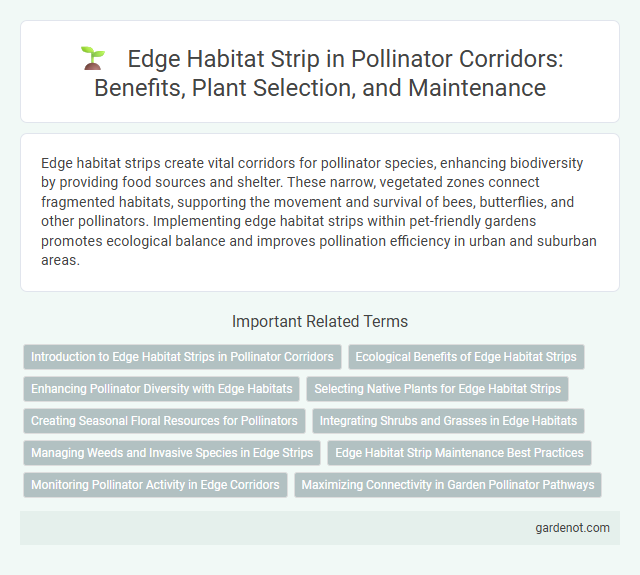Edge habitat strips create vital corridors for pollinator species, enhancing biodiversity by providing food sources and shelter. These narrow, vegetated zones connect fragmented habitats, supporting the movement and survival of bees, butterflies, and other pollinators. Implementing edge habitat strips within pet-friendly gardens promotes ecological balance and improves pollination efficiency in urban and suburban areas.
Introduction to Edge Habitat Strips in Pollinator Corridors
Edge habitat strips in pollinator corridors serve as critical transitional zones between different ecosystems, providing abundant floral resources and nesting sites for diverse pollinator species. These strips enhance biodiversity by supporting native bees, butterflies, and other pollinators, facilitating movement and gene flow across fragmented landscapes. Strategic placement of edge habitat strips in agricultural or urban areas increases pollination efficiency, boosts crop yields, and strengthens ecosystem resilience.
Ecological Benefits of Edge Habitat Strips
Edge habitat strips enhance biodiversity by providing crucial foraging and nesting sites for pollinators such as bees, butterflies, and hummingbirds. These strips create microclimates that support diverse plant species, boosting ecosystem resilience and improving pollination services. Increased insect activity in edge habitats also promotes balanced pest control, benefiting adjacent agricultural fields.
Enhancing Pollinator Diversity with Edge Habitats
Edge habitat strips create transitional zones between forests and open areas, offering diverse floral resources and nesting sites critical for sustaining pollinator diversity. These habitats support a variety of pollinators, including bees, butterflies, and hoverflies, by providing continuous foraging opportunities throughout the growing season. Enhancing edge habitats improves ecosystem resilience, promotes pollination services, and supports agricultural productivity.
Selecting Native Plants for Edge Habitat Strips
Selecting native plants for edge habitat strips enhances pollinator corridors by providing essential nectar, pollen, and shelter specific to local pollinators. Native species such as milkweed, coneflowers, and goldenrod support diverse pollinator populations and improve habitat connectivity. Incorporating a variety of flowering plants that bloom sequentially throughout the growing season maximizes food availability and strengthens ecosystem resilience.
Creating Seasonal Floral Resources for Pollinators
Edge habitat strips designed with diverse native flowering plants provide crucial seasonal floral resources that support pollinator health and biodiversity. By incorporating early-blooming, mid-season, and late-flowering species, these strips ensure a continuous nectar and pollen supply throughout the growing season. This strategic planting enhances pollinator foraging opportunities and promotes stable populations of bees, butterflies, and other beneficial insects essential for ecosystem pollination services.
Integrating Shrubs and Grasses in Edge Habitats
Integrating shrubs and grasses in edge habitat strips creates a diverse structural environment that supports pollinator species by providing abundant nectar sources and nesting sites. Native shrub species such as Ceanothus and Salix combined with native perennial grasses like Bouteloua and Schizachyrium enhance habitat complexity, boosting pollinator abundance and diversity. This blend of vegetation also improves ecological connectivity, facilitating movement and genetic exchange among pollinator populations in fragmented landscapes.
Managing Weeds and Invasive Species in Edge Strips
Managing weeds and invasive species in edge habitat strips is critical for maintaining pollinator corridors that support biodiversity and ecosystem health. Effective strategies include regular monitoring, targeted removal of invasive plants like Japanese knotweed and purple loosestrife, and promoting native wildflowers that provide essential forage for bees, butterflies, and other pollinators. Integrating these practices enhances habitat quality, reduces competition from invasive species, and sustains pollinator populations along corridor edges.
Edge Habitat Strip Maintenance Best Practices
Edge habitat strips require regular maintenance to support pollinator diversity and ecosystem health. Mowing schedules should be adjusted to avoid peak blooming periods, allowing native flowers to flourish and provide continuous nectar sources. Incorporating selective pruning and invasive species removal enhances plant variety and structural complexity, critical for shelter and foraging of native pollinators.
Monitoring Pollinator Activity in Edge Corridors
Monitoring pollinator activity in edge habitat strips involves systematic observation and data collection on species diversity and frequency. Utilizing tools such as automated acoustic sensors and visual surveys enhances detection of key pollinators like bees, butterflies, and hoverflies. Consistent monitoring informs management practices that optimize habitat quality and connectivity within pollinator corridors.
Maximizing Connectivity in Garden Pollinator Pathways
Edge habitat strips serve as vital connectors that enhance garden pollinator pathways by providing continuous foraging resources and shelter for bees, butterflies, and other pollinators. Strategically planting native wildflowers and shrubs within these strips maximizes connectivity between fragmented habitats, promoting gene flow and biodiversity resilience. Maintaining varied vegetation layers in edge strips supports diverse pollinator species, creating an effective corridor that sustains pollination services across urban and suburban landscapes.
Edge habitat strip Infographic

 gardenot.com
gardenot.com